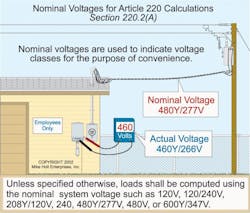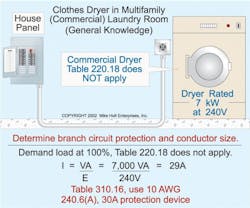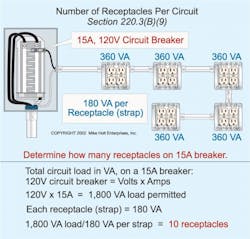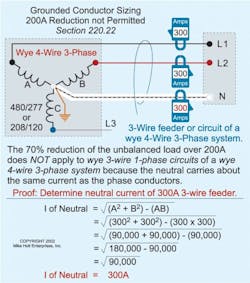Thank you for visiting one of our most popular classic articles. If you’d like to see updated information on this topic, please check out this recently published article, Load Calculations — Part 1. |
Note: This article is based on the 2002 NEC.
Even if you work with stamped drawings, you'll eventually need to do commercial load calculations in the field or on a licensing exam. The National Electrical Code (NEC) covers commercial calculations in Art. 220, but other Articles also apply. For example, you must know the definitions in Art. 100, be familiar with what Art. 210 says about continuous loads, and understand the overcurrent protection requirements set forth in Art. 240.
Two items associated with this type of calculation repeatedly need clarification:
- Voltage — The voltage to use for your calculations depends on the system design voltage. Thus when you calculate branch-circuit, feeder, and service loads, you must use a nominal system voltage of 120V, 120/240V, 208Y/120V, 240V, 347V, 480Y/277V, 480V, 600Y/347V, or 600V unless otherwise specified (220.2) (Fig. 1 below).
- Rounding — Refer to 200.2(B) to end the rounding mystery. When the ampere calculation exceeds a whole number by 0.5 or more, round up to the next whole number. If the extra is 0.49 or less, round down to the next whole number. For, example, round 29.5A up to 30A, but round 29.45A down to 29A.
Specific loads
Article 220 doesn't cover all specific loads. For example, you'll find motors in Art. 430 and air conditioners in Art. 440. To know if you should look in another Article, use the NEC index.
Dryers. Size the branch-circuit conductors and overcurrent protection device for commercial dryers to the appliance nameplate rating. Calculate the feeder demand load for dryers at 100% of the appliance rating. If the dryers run continuously, you must size the conductor and protection device at 125% of the load [210.19(A), 215.3, and 230.42]. Table 220.18 demand factors don't apply to commercial dryers.
Let's apply what we've just learned. What size branch-circuit conductor and overcurrent protection does the NEC require for a 7kW dryer rated 240V when the dryer is in a multi-family dwelling laundry room (Fig. 2)?
I = P ÷ E = 7,000W ÷ 240V = 29A
The ampacity of the conductor and overcurrent device must be at least 29A (240.4). Per Table 310.16, a 10 AWG conductor at 60°C is rated 30A. Therefore, you must use a 30A breaker with a 10 AWG conductor.
Electric heat [424.3(B)]. Size branch-circuit conductors and the overcurrent protection device for electric heating to not less than 125% of the total heating load, including blower motors. Calculate the feeder/service demand load for electric heating equipment at 100% of the total heating load.
Kitchen equipment. Size branch-circuit conductors and overcurrent protection for commercial kitchen equipment per the appliance nameplate rating.
To determine the service demand load for commercial kitchen equipment that has thermostatic control or intermittent use, apply the demand factors from Table 220.20 to the total connected kitchen equipment load. The feeder or service demand load can't be less than the sum of the two largest appliance loads. The demand factors of Table 220.20 don't apply to space-heating, ventilating, or air-conditioning equipment.
Laundry equipment. Size these circuits to the appliance nameplate rating. You can assume a laundry circuit isn't a continuous load and that commercial laundry circuits are rated 1,500VA — unless noted otherwise in the project drawings or exam question.
Lighting. The NEC requires a minimum load per square foot for general lighting, depending on the type of occupancy [Table 220.3(A)]. For the guestrooms of hotels, motels, hospitals, and storage warehouses, you can apply the general lighting demand factors of Table 220.11 to the general lighting load.
Assume the general lighting load for commercial occupancies other than guestrooms of motels, hotels, hospitals, and storage warehouses is continuous. Calculate it at 125% of the general lighting load listed in Table 220.3(A).
Receptacles
You don't do all receptacle load calculations the same way. The NEC has separate requirements, depending on the application.
Multi-outlet receptacle assembly. For service calculations, consider every 5 feet (or less) of multi-outlet receptacle assembly to be 180VA. When you can reasonably expect a multi-outlet receptacle assembly to power several appliances simultaneously, consider each foot (or less) as 180VA for service calculations. Normally, a multi-outlet receptacle assembly isn't a continuous load [220.3(B)(8)].
Receptacle VA load. The minimum load for each commercial or industrial general-use receptacle outlet is 180VA per strap [220.3(B)(9)]. Normally, receptacles aren't continuous loads.
Number of receptacles permitted on a circuit. The maximum number of receptacle outlets permitted on a commercial or industrial circuit depends on the circuit ampacity. To calculate that number, divide the VA rating of the circuit by 180VA for each receptacle strap.
Total circuit VA load for a 15A circuit:
120V × 15A = 1,800VA
Number of receptacles per circuit:
1,800VA ÷ 180VA = 10 receptacles
Receptacle sizing. The NEC permits 15A circuits in commercial and industrial occupancies, but some local codes require a minimum 20A rating (310.5).
Receptacle service demand load. In other than dwelling units, you can add — to the lighting loads — receptacle loads computed at not more than 180VA per outlet per 220.3(B)(9). You can also add fixed multi-outlet assemblies computed per 220.3(B)(8). Both of these must adhere to the demand factors given in Table 220.11 or in Table 220.13.
Bank and office general lighting and receptacles. Calculate the receptacle demand load at 180VA for each receptacle strap [220.3(B)(9)] if the number of receptacles is known, or 1VA for each square foot if the number of receptacles is unknown [Table 220.3(A) Note b].
Signs
The NEC requires each commercial occupancy that's accessible to pedestrians to have at least one 20A branch circuit for a sign [600.5(A)]. The load for the required exterior signs or outline lighting must be at least 1,200VA [220.3(B)(6)]. A sign outlet is a continuous load. You must size the feeder load at 125% of the continuous load [215.2(A)(1) and 230.42].
The following question will allow you to practice what we've just covered. What's the demand load for one electric sign?
1,200VA × 1.25 = 1,500VA
Neutral calculations
The neutral load is the maximum unbalanced demand load between the grounded (neutral) conductor and any one ungrounded (hot) conductor — as determined by the calculations in Art. 220, Part B. This means you don't consider line-to-line loads when sizing the grounded (neutral) conductor. What about load reduction? That depends on certain factors, which we'll look at next.
Reduction over 200A. You can reduce the feeder/service net computed load for 3-wire, single-phase or 4-wire, 3-phase systems that supply linear loads for that portion of the unbalanced load over 200A, by a multiplier of 70%.
To see how this would work for an actual installation, determine the neutral demand load for a balanced 400A, 3-wire, 120/240V feeder.
Total neutral load for 400A service:
First 200A at 100%: 200A × 1.00 = 200A
Remainder at 70%: 200A × 0.70 = 140A
Total demand load: 200A × 140A = 340A
Reduction not permitted. You can't reduce the neutral demand load for 3-wire, single-phase, 208Y/120V or 480Y/277V circuits that consist of two line wires and the common conductor (neutral) of a 4-wire, 3-phase wye system. This is because the common (neutral) conductor of a 3-wire circuit connected to a 4-wire, 3-phase wye system carries about the same current as the phase conductors [310.15(B)(4)(b)].
In addition, you can't reduce the neutral demand load for nonlinear loads supplied from a 3-phase, 4-wire, wye-connected system, because they produce triplen harmonic currents that add on the neutral conductor. This situation can require the neutral conductor to be larger than the ungrounded conductor load (220.22 FPN 2).
Knowing the correct way to do commercial load calculations makes you more valuable because you can play a key role in the field design, inspection, and implementation process. It's one more skill that helps you do the job right the first time.
About the Author

Mike Holt
Mike Holt is the owner of Mike Holt Enterprises (www.MikeHolt.com), one of the largest electrical publishers in the United States. He earned a master's degree in the Business Administration Program (MBA) from the University of Miami. He earned his reputation as a National Electrical Code (NEC) expert by working his way up through the electrical trade. Formally a construction editor for two different trade publications, Mike started his career as an apprentice electrician and eventually became a master electrician, an electrical inspector, a contractor, and an educator. Mike has taught more than 1,000 classes on 30 different electrical-related subjects — ranging from alarm installations to exam preparation and voltage drop calculations. He continues to produce seminars, videos, books, and online training for the trade as well as contribute monthly Code content to EC&M magazine.




